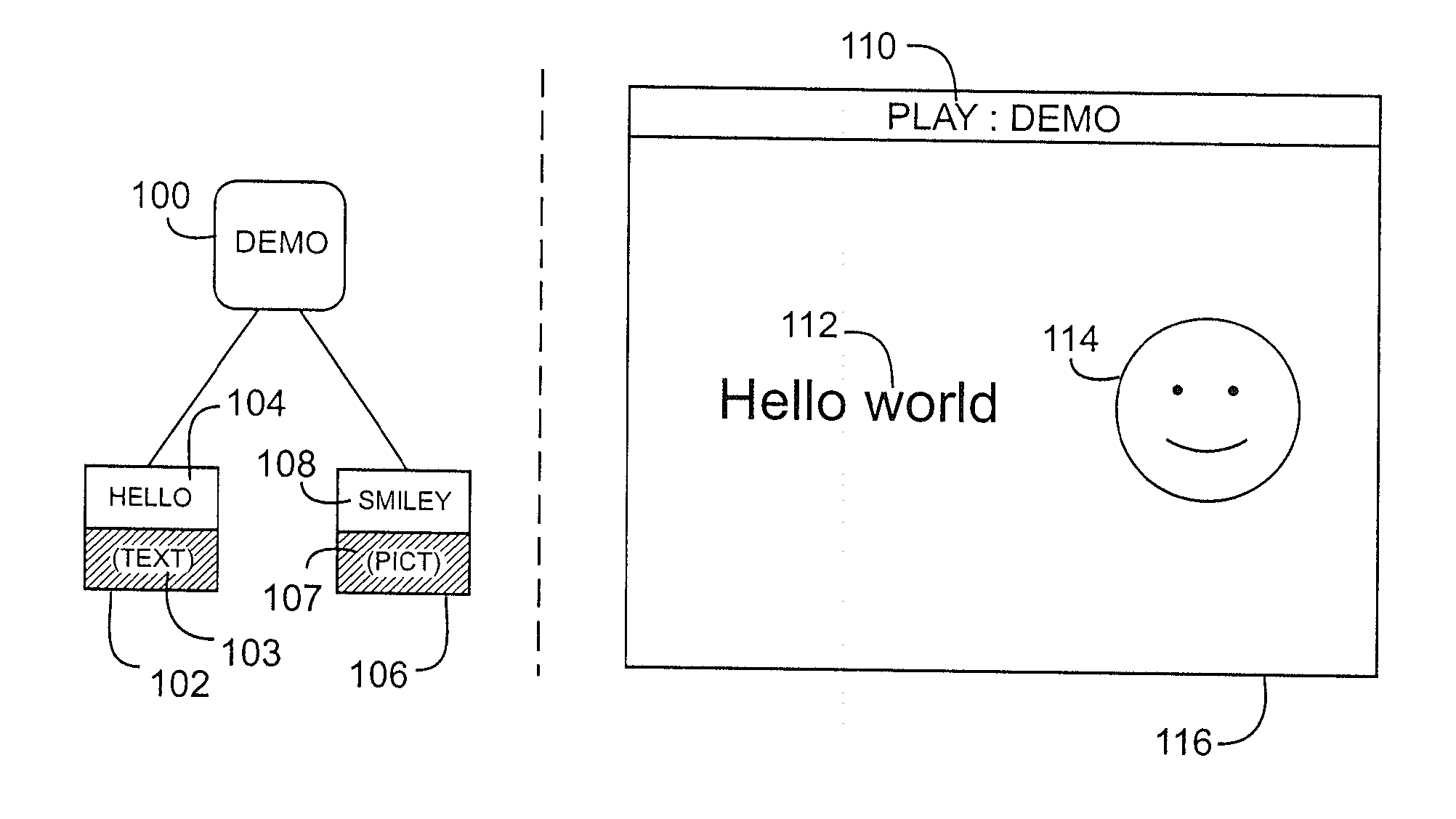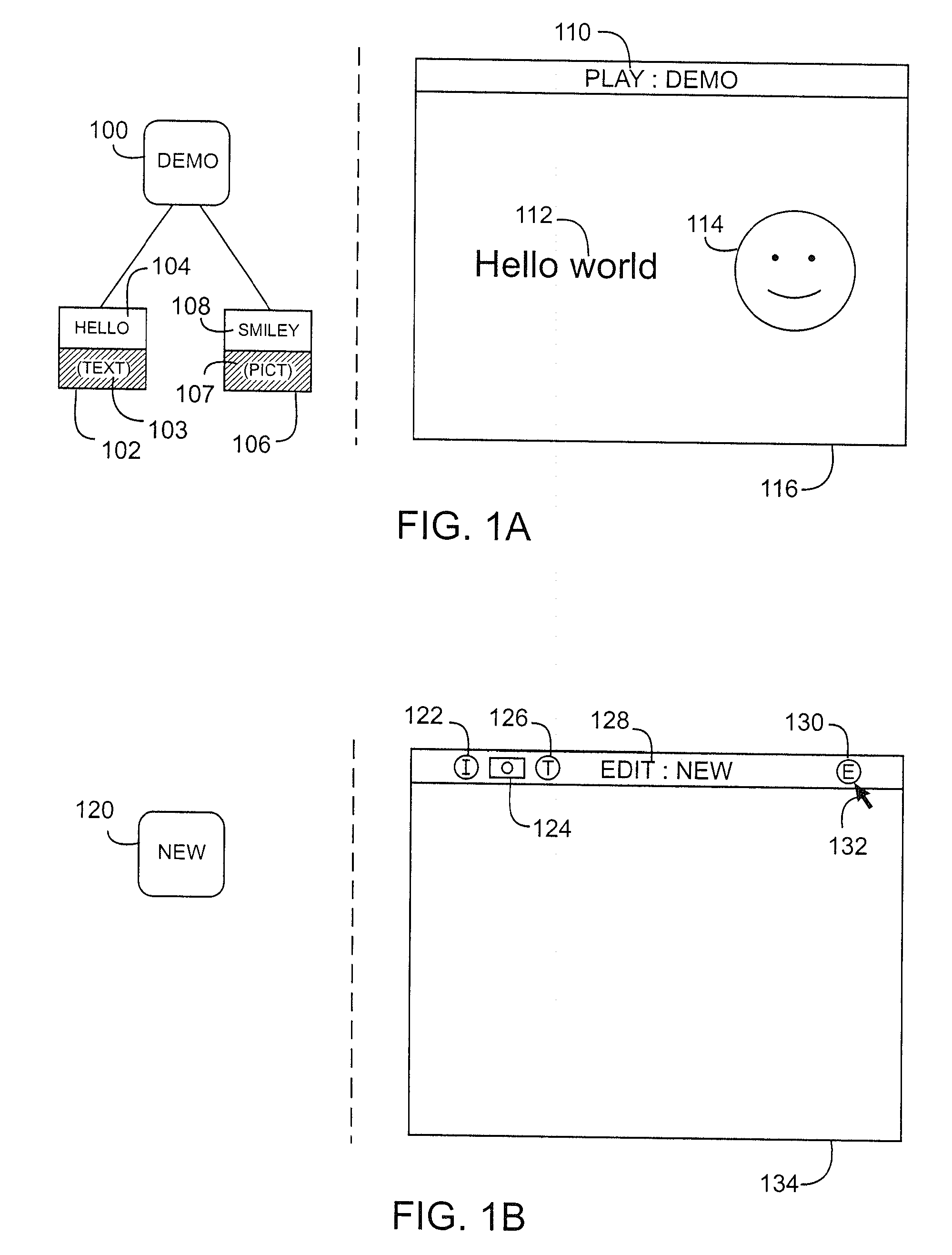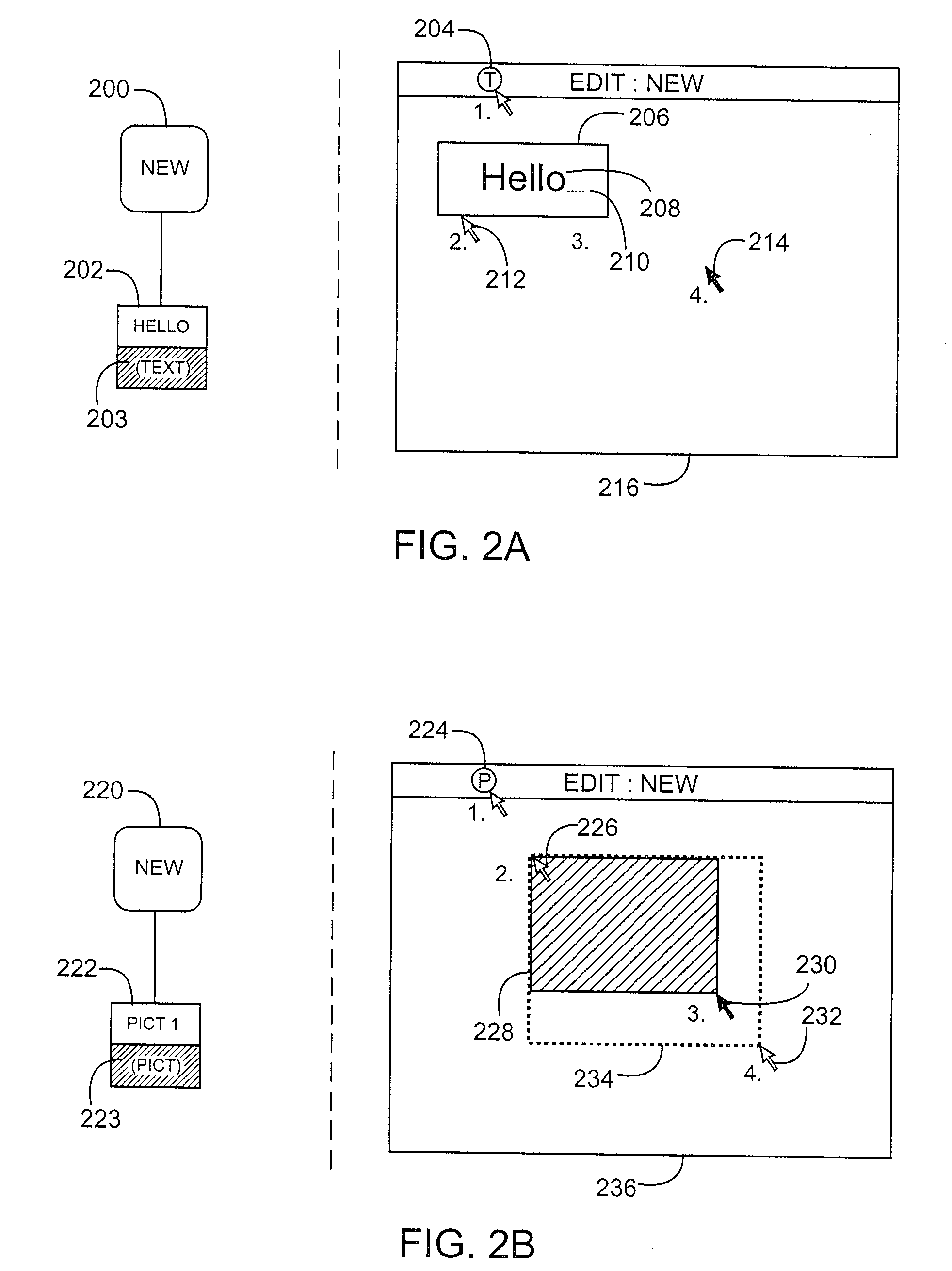Furthermore, the evolution of these tools has failed to keep pace with the growing
mass market of
computer users.
In particular, many of the authoring tools were initially designed for professional use, and attempts to “dumb them down” for non-professional users have lead to mixed results.
In systems where the author is assumed to be sophisticated, a great deal of power and control is generally provided for specifying playback behavior, but at a price in terms of difficulty and complexity.
Regardless of the specific instructions supported by a particular scripting method, current methods of scripting are often unsatisfactory due to the procedural nature of scripting.
Especially when dealing with highly interactive multimedia presentations with numerous possible states and paths, the step-by-step nature of the script tends to obscure the true structure of the content, and requires substantial mental
visualization, i.e. sophistication, on the part of the author to be used effectively.
As a result, current methods of scripting have significant drawbacks in multimedia authoring systems where ease of use for unsophisticated authors is needed.
One drawback is that the procedures used to create the scripts are abstract and fragmented, and do not correspond either directly or intuitively to the shape and structure of the resulting multimedia presentation.
This problem becomes worse as the size and complexity of the multimedia presentation increases.
To create a set of scripts that represents a highly interactive or
expansive presentation, a large number of non-intuitive, interrelated procedures must be performed, often presenting a complex or frustrating burden to authors, particularly those who are inexperienced.
Another drawback is that current methods of scripting frequently result in rigid or too simplistic algorithms for determining the activity in a presentation.
This tendency often leads to mechanical-looking results and misses the objective of creating appealing and entertaining multimedia content.
For authors attempting to create multimedia content that is attractive or interesting to a viewing audience, this presents a burden in delivering appropriate results.
Therefore, current methods which use scripting to enable the author to specify the playback behavior of media objects are generally unable to provide the
clarity, intuitiveness, and ease of use required to enable unsophisticated authors to produce high quality multimedia content.
Regardless of the specific methods used to associate media objects with roles or events within a template, current methods that use templates are frequently unsatisfactory due to the pre-programmed nature of the template, and because the author generally has no input into the structure of the template or the functionality it provides.
Particularly with regard to multimedia presentations where individuality or uniqueness is desirable, an author's creative intentions are frequently unable to be realized using templates.
As a result, current methods using templates have significant drawbacks where flexible or detailed control over the playback of media objects is desired.
One drawback with current methods using templates is that the procedures undertaken to develop templates cannot take into account each individual author's needs and tastes, but must rather make broad assumptions about authors in general.
This limits the ability of templates to produce results which satisfy a variety of author's intentions and preferences.
Another drawback is that current methods using templates typically result in media object behavior that is generic or overly simplistic.
This tendency often leads to multimedia content which is “canned” looking or otherwise unsophisticated.
For authors that wish to create unique or sophisticated content, this presents a burden in delivering appropriate results.
Therefore, current systems and methods using templates to enable the author to specify the playback behavior of media objects are generally unable to provide the flexibility and author-specific control needed for satisfactory authoring of custom multimedia content.
Regardless of the specific methods used for defining playback behavior in time, current methods that use timelines are frequently unsatisfactory due to the inherently linear nature of representing object behavior along a timeline.
Structures such as these are not easy to represent within the linear format of timelines.
As a result, current methods using timelines have significant drawbacks when interactive or non-linear behavior for media objects is desired.
One drawback with current methods using timelines is that in order to achieve interactive playback, the timeline must be broken into segments, each of which represents part of the presentation.
This problem becomes worse as the level of interactivity of the presentation increases, often presenting a to complex or frustrating burden to authors, particularly those who are inexperienced.
Another drawback is that timelines, even those which have been broken into individually controllable segments, typically produce multimedia content that has a repetitive or “looping” feel.
This is because with timelines it is difficult to define several independently occurring processes, each with their own sense of time, that overlap and interact in unpredictable and varied ways.
This limitation presents a substantial burden in creating multimedia content with enough variety and interest to merit extended or repeated viewings.
But timeline templates present similar problems to the templates already discussed.
They are inflexible, limit the creative input of the user and often result in a canned look.
Therefore, current systems and methods using timelines to enable the author to specify the playback behavior of media objects are generally unable to provide the flexibility and variety needed for satisfactory authoring of non-linear multimedia content.
This approach often results in problems with the quality of the “Web surfing” experience provided to users of the browser.
Particularly when it comes to effective presentation of link destinations, and the smoothness of transitions between Web pages, the linking method of the
World Wide Web and its implementation by Web browsers can have significant drawbacks.
The main problem with the linking method of the
World Wide Web is that the procedures a
Web browser uses to access data for a new page do not begin until the triggering event for the link has occurred.
This means that after clicking on a link, the user must wait for the data of the new page to load before seeing the new page, which often takes a substantial amount of time.
Furthermore, when using a browser, the user cannot preview the actual destination of the link prior to committing to the page transition, but can only evaluate the destination based on information provided in the current page, which is frequently inadequate.
As a result, users frequently become frustrated after triggering links which are slow to load, irrelevant to the purposes at hand, or both.
This presents a substantial burden in providing an efficient and pleasing “Web surfing” experience for the user.
Therefore, current authoring and playback systems which depend on the linking method of the
World Wide Web to provide linking of content across different computers inherit the drawbacks of that method, which include the inability to effectively represent link destinations to users and the inability to implement page changes smoothly.
As discussed above, methods currently in use for authoring multimedia content and for linking and viewing distributed multimedia content present a variety of drawbacks to the user.
Finally, when taken as a whole, current systems for authoring, distributing and viewing multimedia content present a collective burden.
Each only addresses a specific part of a much larger picture, resulting in incompatibilities and inefficiencies as content is passed from one tool to the next along the authoring, distribution and viewing chain.
 Login to View More
Login to View More  Login to View More
Login to View More 


